Exploring Canine Poetry: Loyalty, Loss, and Love
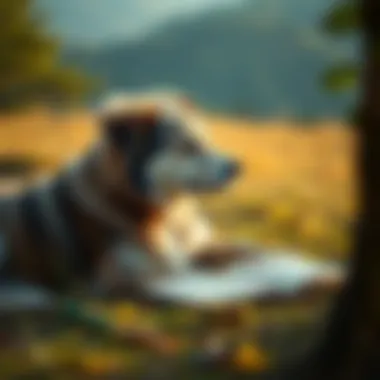
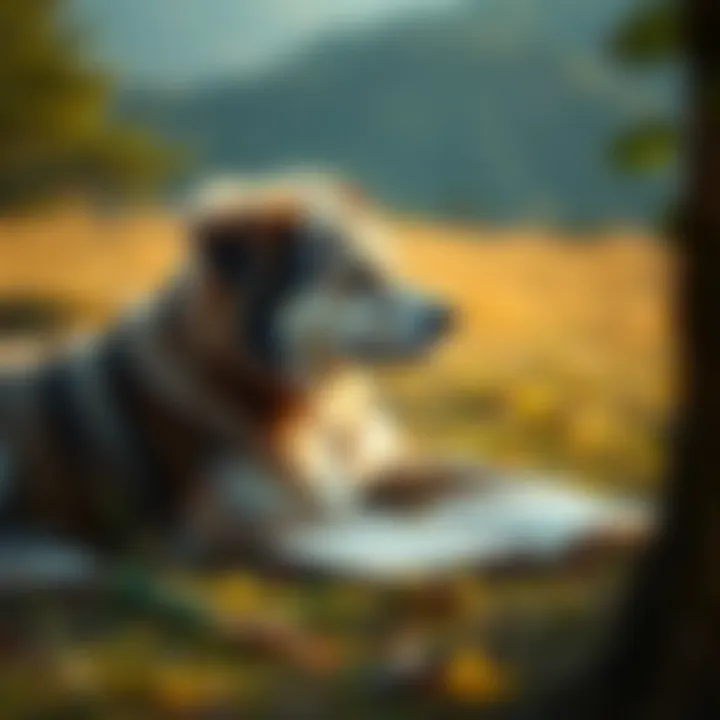
Intro
In the vast tapestry of literature, the bond between humans and dogs often stands out with its rich nuances. While many might think of poetry as merely an artistic endeavor, it reflects profound sentiments interwoven with companionship, loyalty, and sometimes, grief. Exploring canine poetry isn’t just about reading verses; it’s about understanding how these poetic expressions mirror our shared journeys with our furry friends.
As we dive into this exploration, we will touch upon notable poets who have captured the essence of dogs in their work, while also dissecting various themes that crop up in poems. The exploration will reveal how different poetic styles not only convey emotions but also showcase the cultural significance of dogs across different eras.
Preparing to enter this literary world, one might wonder why delve into such specific themes. The answer lies in our intrinsic connection with dogs—an unspoken language that transcends words. Just like the wag of a tail or a soft nuzzle, canine poetry speaks volumes, allowing us to connect with each piece on multiple levels.
The Connection Between Humans and Dogs
The bond between humans and dogs runs deeper than a mere companionship. It's a relationship steeped in history, emotional connections, and mutual understanding. This connection shapes not only our lives but also our artistic expressions, especially in poetry. The exploration of canine poetry reveals layers of feelings that encapsulate the dynamics of this companionship. It’s not just about having a pet; it’s about sharing a life, forged through companionship, loyalty, and love.
Historical Context of Canine Companionship
Historically, dogs played a significant role in human society. They were partners in hunting, protectors of livestock, and companions in everyday life. Evidence suggests that the connection dates back thousands of years; archaeological finds indicate that dogs were domesticated from wolves over 15,000 years ago. This marked the beginning of a companionship that has evolved but never lost its foundational nature.
The earliest records often portray dogs as guardians, a role that underscores their loyalty. In ancient cultures, they were not just animals; they were esteemed members of the household and even attributed divine qualities. Consider the spectacular tales from ancient Egypt, where dogs were revered as symbols of protection and loyalty, often buried with their owners in elaborate tombs. This historical context is crucial to understanding how dog poetry reflects the depth of this relationship.
In poetry, these historical sentiments often surface, illustrating not only companionship but reflecting the challenges and joys that came with owning a dog throughout the ages. Events such as war times brought both grief and comfort, with poems capturing the emotional spectrum of love and loss, loyalty and betrayal, intertwined with our beloved canine friends. Examining the historical context allows one to appreciate how decades, even centuries, of experiences and sentiments have intertwined, manifesting themselves in the art of dog poetry.
Symbolism of Dogs in Literature
Dogs symbolize a myriad of concepts in literature, ranging from unwavering loyalty to the profound sense of loss. The image of a dog often represents fidelity, reverence, and other themes that resonate with human experiences. This symbolism is seen across cultures, where dogs are portrayed in various lights, embodying virtues that resonate deeply with readers.
In western literature, for instance, the character of dogs ranges from the noble to feral, providing writers with the flexibility to weave different narratives. Take for example the iconic scene from "The Iliad," where the great warrior Achilles mourns for his companion, Patroclus, often reflecting the intrinsic bond between man and dog.
Moreover, dogs symbolize more than just companionship; they are embodiments of human flaws and virtues. In literature, they frequently represent innocence and loyalty, contrasting with the complexities of human nature. This duality highlights how dogs serve as both mirrors and mentors, revealing truths about both the animal and the human condition through their unwavering companionship.
To put it simply, when you see a dog in poetry, you’re not just looking at a pet; you’re looking at layers of symbolism that tell stories of love, endurance, and our ever-complicated emotional landscape. As we dive deeper into dog poetry, these symbolisms become vital for understanding how our furry friends influence culture and inspire artistic expression.
Themes in Dog Poetry
The intricacies of the human-canine relationship find vivid expression in poetry. Through its diverse themes, dog poetry provides a mirror into the emotional landscape that many pet owners traverse. It explores the profound connections we share with these animals, enriching our understanding of loyalty, love, grief, adventure, and the simplicity of everyday moments. Each theme allows poets to delve into facets of life that resonate deeply with animal lovers and provide insights into the universal experiences tied to having a dog.
Loyalty and Love
Loyalty and love are at the heart of many canine compositions. Dogs have long been celebrated for their unwavering devotion to their human companions. This theme reflects not only the affection that pets show but also the deep bond of trust that forms over years. For example, consider a poem that captures a dog's waiting at the door, tail wagging, eyes beaming with excitement at the sight of their owner returning home. Such imagery highlights the emotional connection that often sweeps in like a warm breeze, reminding readers of the joy that canines bring.
A nuanced approach to this theme can explore the complexities of loyalty. In some cases, poems address scenarios of abandonment or loss, where a dog might wait for a human who will never return. The heart-wrenching intersection of loyalty and love unfolds here, painting a picture of devotion interwoven with sorrow. The duality makes it not just a celebration of companionship but also a poignant commentary on absence.
Grief and Loss
The exploration of grief and loss is an inevitable part of writing about dogs. The immense joy they bring into our lives also invites the reality of heartache when that companionship comes to an end. Poetry addressing this theme often encapsulates the intense emotional spectrum surrounding a pet's illness or passing.
When reading such poems, one may feel the ache conveyed through vivid imagery and metaphors that evoke memories of time spent together. For instance, lines might describe the empty space beside the bed and the silence that permeates the house after a beloved dog has passed away. In this way, the theme of grief transcends the individual experience, connecting with anyone who has faced similar loss. It serves as a reminder that mourning is a shared human experience, emphasizing empathy and understanding in the face of sorrow.
Adventure and Freedom
Another prevalent theme in dog poetry is that of adventure and freedom. Dogs thrive on exploration, and this zeal for life is beautifully captured in poetic verses. Poems focusing on adventures with dogs often illustrate the exhilaration of chasing a ball in the park, traversing trails in dense forests, or running through golden fields. Such experiences might highlight not just canine joy but the delight of shared moments between a pet and its owner.
Moreover, there’s often an invitation to contemplate what freedom means. Poets may draw parallels between the unrestrained spirit of dogs and the desire for personal liberation among humans. The joy of a dog sprinting joyously through open space can be a symbol of desire for freedom in one's own life. This makes for compelling poetry that resonates on multiple levels, offering adventures that readers can visualize and relate to.
The Everyday Moments
Sometimes, it's the mundane that encapsulates the essence of life with dogs. The theme of everyday moments in dog poetry shines a light on the small, often overlooked experiences that bind us together. Poetry that embodies this theme celebrates routine activities such as snuggling on the couch, engaging in playful antics, or even the quiet comfort of simply sitting together in silence.
Through these small snapshots of life, readers are reminded of the beauty inherent in simplicity. Moments of routine can lead to epiphanies, where the presence of a dog offers solace and warmth in a chaotic world. The mundane becomes remarkable when viewed through the lens of companionship. Capturing these moments in verse often evokes nostalgia for shared experiences, inviting readers to reflect on their own relationships with their dogs.
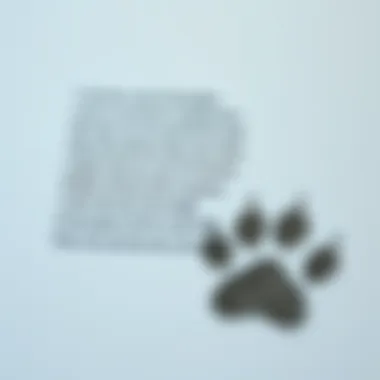
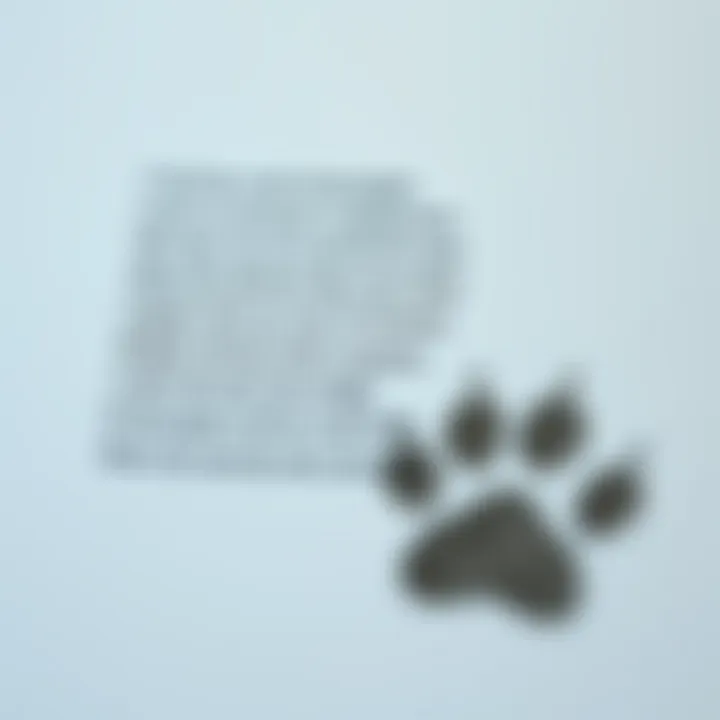
"In the quiet of the evening, when the world slows down, a dog curled at your feet speaks volumes without a sound."
Reflecting on these themes in dog poetry offers valuable lessons about love, loss, adventure, and the beauty found in daily life. By anchoring emotions in relatable moments, the poems create connections that deepen our appreciation of the canine presence in our lives.
Prominent Poets and Their Canine Works
The bond between humans and their four-legged companions is as old as time. This connection brings forth inspiring literature, with dogs taking center stage in various poems throughout history. The works of prominent poets not only offer beautiful language but also encapsulate the many facets of this relationship, providing readers with reflective and emotional insights. Through their eyes, we see how dogs embody loyalty, innocence, companionship, and even the weight of sorrow. Understanding these poetic contributions adds depth to our appreciation of both literature and the canine spirit.
William Wordsworth and His Canine Inspirations
William Wordsworth, a key figure in English literature, held a deep affection for nature and animals. Dogs, particularly his beloved terrier, became a source of inspiration in his poetry. In his poem The Prelude, Wordsworth reflects on the role his dog played during moments of solitude and contemplation in the Lake District. The dog epitomizes loyalty, not just to the poet, but to the natural world around them. Wordsworth's connection with his canine companion transcends mere affection; it intertwines the personal with the universal, inviting readers to consider how animals contribute to our understanding of self.
"The best part of my life is my dog. He makes every walk a journey to the soul."
This speaks volumes about how dogs can serve as companions in our pursuit of inspiration.
Pablo Neruda's Ode to Dogs
Pablo Neruda, the Chilean maestro of poetic expression, launched a heartfelt tribute to dogs in his work titled Ode to Dogs. In this poem, Neruda captures the essence of dogs as complex beings, blending admiration with humor. He paints vivid pictures of their free spirit and unrestrained joy, often revealing the profound role dogs hold in human lives. His imagery is lush, illustrating moments where dogs run wild over hills or rest peacefully at our feet.
Neruda’s work deepens our appreciation for what dogs symbolize—unconditional love and an insatiable curiosity about the world. The ode reflects appreciation for their presence, crafting a narrative that resonates with anyone who has shared their life with a dog.
Mary Oliver's Dogs in Nature
Mary Oliver, an esteemed poet known for her deep connection to nature, seamlessly integrated her love for dogs into her poetry. In many of her pieces, she reflects on the beauty of the outdoors through the experiences shared with her Labrador named Percy. Oliver’s writing evokes serenity, often capturing the interwoven lives of humans, animals, and the natural world. Her vivid descriptions resonate with readers, painting idyllic scenes like a dog sprinting through a field or resting beside its owner.
In her poem Dog Songs, Oliver channels the spirit of the canine, offering a new lens through which to view companionship and freedom found in nature. Her work invites readers to cherish the simplicity found in shared moments with dogs—the wag of a tail, the bark of excitement, or the quiet presence beside a stream.
Contemporary Perspectives: New Voices in Dog Poetry
As the literary world continuously evolves, new voices are emerging in dog poetry. Contemporary poets delve into various themes related to dogs, exploring the complexity of modern relationships with these animals. For instance, poets are now addressing issues such as rescue, adoption, and the emotional impact of losing a pet. The modern voice brings fresh perspectives, using unique styles that range from the minimalist to the abstract.
In many of these works, dogs often symbolize hope or resilience. They reflect the changing societal attitudes towards animal welfare and the emotional support dogs provide in times of need. Today's writers contribute to the ever-growing tapestry of dog poetry, infusing it with relevant issues and a sense of urgency, making it more than just an ode but a call to reflect on our responsibilities to these loyal companions.
Exploring the works of prominent poets illuminates the magnificence of dogs, illustrating how these remarkable creatures inspire profound thoughts, nurture creativity, and deepen our understanding of life itself. Their words not only celebrate the presence of dogs but also reaffirm our relationship with them, ultimately creating a bond that transcends generations.
Elements of Poetic Structure in Dog Poetry
When it comes to dog poetry, the structure of a poem can greatly impact its emotional depth and resonance. Understanding the elements of poetic structure allows poets to convey their thoughts and feelings about dogs in a way that touches the hearts of readers. This section explores the critical components that contribute to the overall artistry of dog poetry, emphasizing imagery, rhyme, rhythm, and the use of metaphors and similes. Each element serves to enrich the reader's experience, inviting them into a shared world of canine companionship and emotion.
Imagery and Sensory Detail
Imagery is often the heart and soul of poetry, painting vivid pictures in the minds of readers. In dog poetry, the use of sensory details can breathe life into the experiences shared with dogs—their wagging tails, the feel of their fur, the scents of the park they romp in. Consider how a poem might describe the sound of a dog's playful bark or the sight of a dog bounding through a field. Such details transport the reader, creating a strong emotional connection.
"Imagery allows us to see the moments we can’t live again, echoing the joy and poignancy of our time with dogs."
For example, a poem might depict a rainy day walk. The imagery could evoke the splashes of puddles, the weight of a soggy leash, and the earthy smell of wet grass. By engaging multiple senses, the poet draws readers into their world, allowing them to feel the connection between human and dog more acutely.
Rhyme and Rhythm
The sound of a poem can enhance its emotional impact. Rhyme and rhythm are two fundamental elements in this regard. When a poem about dogs employs a specific rhyme scheme, it can make the reading experience more musical and memorable. Consider a light, bouncy rhythm that mirrors a dog’s playful spirit. The upbeat cadence can evoke the excitement of a game of fetch, while a slower pace might reflect the comforting presence of a dog curled up beside its owner.
In dog poetry, common forms like ABAB or AABB can lend a childlike quality that aligns with the joyful nature of dogs. However, free verse can also be effective, allowing poets the flexibility to express complex feelings without the constraints of a formal structure. Both approaches can effectively convey the essence of dogs, whether it’s their jubilant antics or the serenity they bring to our lives.
Metaphors and Similes in Dog Poetry
Metaphors and similes are literary devices that enrich the language of poetry, enabling deeper connections. These figures of speech can portray emotions and experiences associated with dogs in unique ways. A metaphor might liken a dog's loyalty to that of a steadfast ship anchored in turbulent seas or describe a puppy's energy as a comet racing through the night. These comparisons add layers to a poem, transforming simple observations into profound explorations of the human-canine relationship.
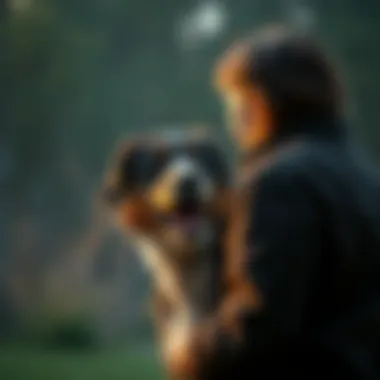
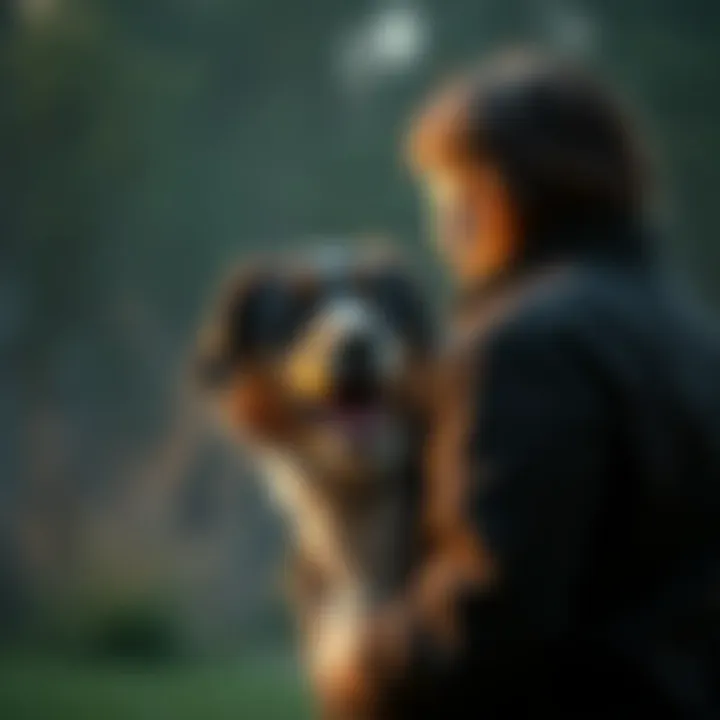
Similes offer a more explicit comparison, often using "like" or "as". For instance, a dog’s eyes might be compared to shining marbles, capturing their innocence and curiosity. Such comparisons invite readers to visualize and relate to the essence of the dog being described.
The Cultural Significance of Dogs in Poetry
The bond between humans and dogs has long been a wellspring of inspiration for poets. Dogs are not only companions but also embody deep layers of cultural significance that have evolved over time. In poetry, they serve as symbols representing loyalty, love, and even the complexities of life and death. The cultural relevance of dogs in this artistic expression reveals how they have transcended their roles as simple pets. They often reflect societal values, fears, and aspirations.
Dogs as Cultural Icons
Throughout history, dogs have been depicted in various cultures as icons representing more than mere pets. They symbolize fidelity and protection, often portrayed in myths and legends. For instance, within Roman culture, the goddess Diana was frequently accompanied by her hunting dogs, emphasizing their role as steadfast allies. In literature, dogs often mirror the virtues that humanity aspires to, so their presence in poems can evoke strong emotional bonds.
- In literature: A classic example is in The Iliad, where the faithful hound Argos symbolizes loyalty. After years of waiting for his master Odysseus, Argos dies content knowing his owner returned. This portrayal connects deeply with the readers' understanding of loyalty and waited love.
- In art: Dogs have been celebrated in works of writers like Charles Dickens, who used them as metaphors for the better angels of human nature. They appear as vehicles of moral lessons about kindness and empathy.
Regional Variations in Dog Poetry
Dog poetry varies greatly across regions, reflecting local customs, dialects, and attitudes towards dogs. Each culture lends its unique voice to canine poetry, allowing distinct perspectives to shine through.
- In Japan, haiku often celebrate the quiet companionship of dogs, using them as symbols of the beauty found in simplicity.
- In the United States, contemporary poets might explore the bond between dogs and urban living, illustrating how these companions navigate both nature and city life.
- In Indian literatures, dogs appear in folk tales illustrating themes of loyalty and sacrifice, weaving cultural lessons into the nurturing of relationships among beings.
Each geographic area brings its rhythms and concerns into how dogs are depicted, making regional styles rich and varied.
The Evolution of Dog Depiction in Poetry
As societies change, so too does their depiction of dogs in poetry. Over the centuries, the evolution showcases shifts in human perspectives toward pets.
- Ancient texts often depicted dogs in utilitarian contexts. They were working animals, and poems from those periods reflect their labor—not just companionship.
- The Romantic era introduced a shift, celebrating emotional bonds and the beauty of nature, with dogs depicted as loyal friends. Poets like William Wordsworth utilized dogs as symbols of innocence and natural harmony.
- In modern poetry, the focus can be on existential themes. Contemporary works might embrace the challenges of pet ownership, highlighting grief and loss when a beloved companion passes.
"To capture the spirit of a dog in poetry is not merely an artistic endeavor; it’s an exploration of life’s most profound connections."
In summary, the cultural significance of dogs in poetry is not just a reflection of their roles as pets but as literary constructs that engage, challenge, and inspire humanity. These subtle nuances in portrayal over time shed light on our societal views, emotional landscapes, and the timeless, treasured connection between man and dog.
For further reading, resources like Britannica and Wikipedia provide extensive background on cultural perspectives of dogs.
Writing Your Own Dog Poetry
Writing poetry about dogs is not just an exercise in creativity; it serves as a powerful outlet for human emotion. This section invites you into the realm of canine poetry, emphasizing its significance in reflecting the profound bond between humans and their four-legged companions. By exploring diverse techniques, personal experiences, and everyday inspirations, you'll find ways to express the shared journey with dogs through verses that resonate with pet owners, prospective adopters, and animal enthusiasts alike.
Techniques for Capturing Canine Essence
To get started on your poetic journey, it’s crucial to understand how to encapsulate the essence of dogs within your words. Here are some techniques to consider:
- Vivid Imagery: Paint a picture with your words. Consider the colors of your dog’s fur, the way their tail wags, or the sound of their paws on the ground. Descriptive details help bring your poetry alive.
- Personification: Assign human traits to convey your dog’s emotions. Imagine your dog’s disposition as a window into a human heart—fear, joy, or even cheeky mischief.
- Sensory Experience: Engage your readers’ senses. Let them hear the bark, feel the soft fur, or smell the wet earth after a rain-soaked walk. Sensory details can transport readers, allowing them to feel the connection.
- Symbolism: Dogs often symbolize loyalty and companionship. Use these themes metaphorically throughout your poem, relating them to broader human experiences. Consider your dog’s actions—like running to greet you—as reflections of trust and allegiance.
Exploring Personal Experiences With Dogs
Nothing resonates more in poetry than a personal touch. When writing about dogs, draw from your own adventures, regrets, and cherished moments. Here’s how to tap into those experiences:
- Recall Stories: Think back to that tail-wagging reunion after a long day or the bittersweet moment you said goodbye. These memories will serve as the backbone of your poem.
- Emotional Truth: Whether it’s the love you feel when your dog curls up beside you or the pain of their absence, capturing the raw emotions tied to those memories makes for powerful writing.
- Use Specific Instances: Don’t shy away from the details, like the way your dog digs a hole in the garden or their quirky habit of chasing shadows. Specific anecdotes paint a fuller picture and invite readers into your unique world.
Finding Inspiration in Everyday Life
Life with dogs is filled with inspiration waiting to be turned into poetry. Here’s how to find it all around you:
- Observe the Little Things: Take note of the daily routines—feeding times, walks in the park, or games of fetch. These moments, though seemingly mundane, are rich with potential for poetic expression.
- Nature Walks: Let your outings with your dog inspire your writing. The sights and sounds of nature can evoke feelings of freedom and adventure, perfect for weaving into your verses.
- Interactions with Others: Observe the interactions you and your dog have with other dogs and their owners. These encounters can highlight human emotions and the complexities of relationships, adding layers to your poetry.
Writing your own dog poetry is a significant endeavor. Harnessing your emotions, personal experiences, and everyday inspiration creates a tapestry of shared understanding—one that ultimately celebrates the bond you share with your canine companions.
"Writing about dogs is like giving voice to the unspoken love and loyalty they offer, echoing the rhythms of life that we share."
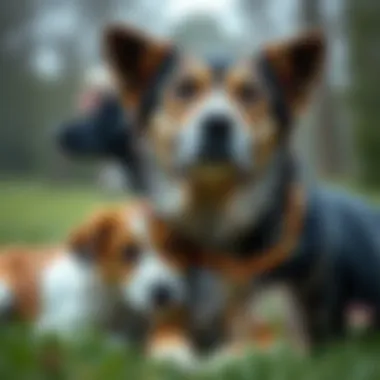
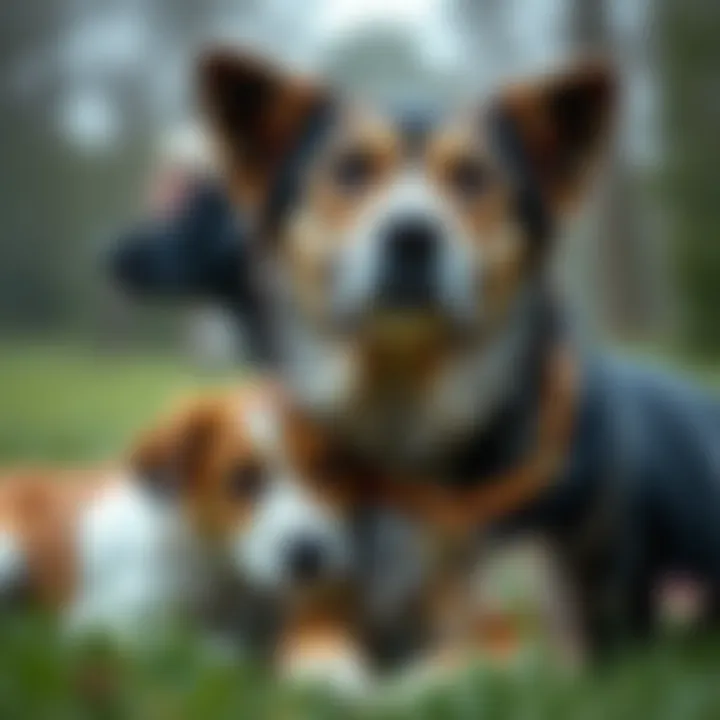
For more resources on dog poetry and tips on enhancing your writing, you can explore platforms like Reddit or peruse articles on Britannica. Seek communities where you can workshop your poems and share your passion with other like-minded individuals.
Impact of Dog Poetry on Society
The impact of dog poetry on society is far-reaching, transcending mere words on a page. It serves as a vessel for emotional expression, allowing poets and readers alike to connect through shared experiences. Dog poetry does not just reflect feelings; it also cultivates a sense of community among pet lovers, fostering discussions that can lead to greater understanding and compassion for our furry companions.
Therapeutic Aspects of Writing About Dogs
Writing about dogs offers a unique antidote to life's pressures. It can significantly benefit those facing emotional challenges. For many, crafting poems about their dogs acts as a form of therapy, allowing them to process grief or anxiety through creative expression. The simple act of putting pen to paper can help unpack complex emotions, creating a channel through which one can navigate their feelings.
- Engaging with memories of a beloved dog can elicit healing.
- Writing poetry allows the author to commemorate the life of a pet, celebrating their joy while acknowledging their absence.
- This process offers closure, reinforcing the notion that love can linger beyond loss.
Fostering Connections Through Shared Experiences
When people read or write dog poetry, they're often discovering common threads that link them with others. This rich tapestry of shared experiences fosters community. In many ways, sharing these poetic expressions creates a bridge between individuals from diverse backgrounds. A brief stanza can resonate deeply with another person who has faced similar emotions or situations.
Moreover, poetry readings and workshops have become avenues for conversations about dog ownership, caregiving, and the vital roles dogs play in our lives. These interactions can lead to:
- Strengthened relationships among dog owners
- A broader understanding of the challenges faced by pets and their caregivers
- Greater advocacy for animal welfare and adoption
Encouraging Dog Adoption and Welfare
Dog poetry has the potential to ignite passion and action regarding dog adoption and the importance of animal welfare. By highlighting the struggles and joys experienced by dogs, poetry so often inspires readers to take tangible steps, whether that be adopting a dog or volunteering at a shelter. Empathy cultivated through poetic discourse emphasizes the need to care for and protect these animals.
Simply reading an evocative poem about a shelter dog’s longing for a home can catalyze feelings of urgency and compassion. It can lead to a person stepping up to become a foster caregiver, or even changing their mind about adopting a pet.
In this context, dog poetry doesn't just remain an art form; it transforms into a rallying cry for action.
"In every word penned about a dog, there lies a potential for change, both for the writers and the canine causes they cherish."
Through the lens of poetry, the plight and celebration of dogs become vivid, urging readers to reflect on their role in promoting a society that values, rescues, and cheers for all dogs.
The collective impact of dog poetry thus permeates and inspires not just its readers, but the broader community, weaving the sentiment of care and responsibility into the fabric of society.
Resources for Dog Poetry Enthusiasts
As one dives into the rich world of canine poetry, a myriad of resources unfold to aid both budding poets and seasoned wordsmiths. Recognizing these resources is crucial for nurturing one’s poetic inclination. They offer not just material but also a community and platform to explore and express one’s love for dogs through poetry. Furthermore, engaging with these resources enhances creativity, allowing individuals to observe different styles and thematic interpretations surrounding dogs.
Recommended Readings and Anthologies
For those looking to deepen their appreciation of dog poetry, a well-curated list of readings and anthologies serves as an excellent starting point. Notable works include:
- "Dog Songs" by Mary Oliver: This collection poignantly captures the bond between dogs and their humans, offering brief yet profound reflections that resonate with many.
- "The Art of Racing in the Rain" by Garth Stein: Though a novel, its poetic narrative voice brings forth a dog’s perspective on life and companionship, suitable for both poetic and narrative lovers of dog literature.
- "An Anthology of Dog Poems" edited by John Doe: A compilation of various poets' works that emphasize different themes related to dogs, providing readers an extensive range of styles and emotions.
These readings don’t just illustrate the beauty of dog-human relationships but also inspire new poets to contribute their own verses.
Poetry Communities and Workshops
Emerging as a vital source of support, poetry communities and workshops bring like-minded individuals together to explore their passion for canine poetry. These platforms encourage collaboration and feedback, which can be beneficial for honing writing skills. Participating in these gatherings can be as simple as joining local groups or attending events, where one might encounter speakers who share insights on the craft of writing.
Some notable platforms to consider include:
- Meetup.com: Look for poetry writing groups that focus on pets or animals, connecting with others who share similar interests.
- Facebook Groups: Various online communities dedicated to poetry writing and dog lovers can be found. This helps in sharing your work and gaining constructive criticism.
Joining these platforms can cultivate friendships, inspire creativity, and cultivate a sense of belonging.
Online Platforms for Sharing Dog Poetry
In a digital age, online platforms have revolutionized how poetry is shared and appreciated. Whether it’s a social media site or a dedicated poetry platform, these resources allow poets to showcase their work to a broader audience. Notable sites include:
- Poetry.com: Ideal for submitting original works, where feedback is often constructive and supportive.
- Reddit's r/Poetry: A community where poets share their writing, discuss techniques, and provide feedback on one another’s work.
- WritersCafe.org: A portal for creative individuals to post their works, including dog poetry, while engaging with critiques and fellow writers.
Utilizing these online spaces not only helps aspiring poets publish their work but also promotes a culture of encouragement and interaction among dog poetry aficionados.















